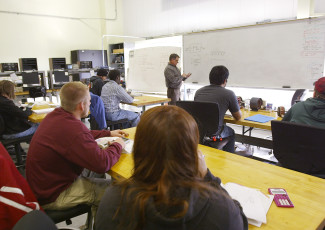Keys to Completion
By Rebecca L. Weber
October 19, 2015
Tutoring services, academic alerts and intervention research help Carroll Community College increase student success.
More Carroll Community College (CCC) students have completed both two- and four-year degrees over a six-year period than the national average, according to research by the National Student Clearinghouse (NSC) Research Center.
The National Student Clearinghouse Research Center tracked two cohorts at the Westminster, Maryland, school: One began in 2007, and another began in 2008. The former had a completion rate of 51.5 percent, compared to a national community college completion rate of 39.9 percent. The 2008 CCC cohort had a rate of 52.8 percent, compared with national community college completion rates of 39.1 percent.
Several campus initiatives contributed to the strong completion rates, according to
CCC President James D. Ball. The various efforts share the goal to increase awareness about the importance of completion as well as transparency about what it takes to earn a degree. Conversations with faculty have included questions such as, “What can we do to strengthen our whole approach? What’s necessary to get students through?” Here are some of the answers CCC has explored.
Tutoring, transformed
A transformation of the tutoring program is one way the college is increasing completion rates. “An aggressive tutoring program is something that any campus could implement without too much difficulty,” Ball says. “Look to the students to support that, or grant money. Our faculty is pushing our students there. The combination of faculty commitment, institutional commitment, and student support is a winning agreement.”
In 2010, the student body voted to allocate $40,000 of their funds to tutoring. This boost to the budget underscores a new commitment to personalized learning and early intervention. Thirty minutes of free weekly tutoring is available to all students. Students make most use of the tutoring center for math, science and writing.
Face-to-face tutoring demands have more than doubled. In 2000, the brick-and-mortar tutoring center had about 6,000 visits; last year, the number increased to 13,000. Each semester, 50 to 60 tutors are available to help students. Some of the tutors are students, and others are paid professionals.
The growth of STEM, allied health and engineering programs means that more students need — and get — help early on.
CCC’s funds from student fees are dropping because of demographic shifts in the county, and so it is looking for grant funds to continue to support the tutoring process. “We just found a new donor willing to support tutoring,” Ball says. “We know that tutoring works.”
Academic alerts
CCC’s academic alert system highlights students who are in trouble. The current system has been in place for four years and works in concert with conversations between faculty and students about the importance of completion.
Maryland Bill 740, the College and Career Readiness and College Completion Act of 2013, motivated the uptake of the current system. “We moved to automation to meet the requirements of the law. We were already looking into how we could pay for it, but the bill did move us forward.”
Faculty members log on, pull up a student’s numbers and then state the problem. Depending on the nature of the problem, the student and/or the support team will be notified.
“It’s something that the faculty have embraced,” Ball says.
Mapping pathways to completion
Last spring, CCC piloted new student planning software, which impacts student thought and behavior in terms of what it really takes to complete a degree.
For example, students can easily see the consequences of changing a major or dropping a class.
Ball says this seems to have increased summer enrollment this year.
Intervention research
About 5 percent of CCC students take a decade to earn a degree. A grant from the state of Maryland for just under $75,000 allowed CCC to reach out to former students who had completed 45 credits or more without graduating. Initially, 180 people were contacted. Thirty came back and completed their degrees, and Ball says a few are still in the pipeline.
“It taught us how intervention works. We created strategies about how to identify them, how to counsel them back,” Ball says. “We plan on institutionalizing that approach.”












